For those who decide to break the apple orchard, it is worth taking the selection of varieties very carefully. In addition to the fact that the apple tree should give a good harvest of fruits, the acquired variety must be adapted to grow in the region. In addition, every gardener wants to harvest until the frost, and store until the beginning of summer next year. A good choice for long preservation will be the planting of autumn varieties of apples.
Content
- 1 Late ripening varieties
- 1.1 Bellefleur chinese
- 1.2 Hero
- 1.3 Bolotovskoe
- 1.4 Gala
- 1.5 Grushevka
- 1.6 Lobo
- 1.7 Long
- 1.8 Cinnamon striped
- 1.9 Cinnamon new (September)
- 1.10 Radiant
- 1.11 Macintosh (Khoroshevka, Autumn Red-sided)
- 1.12 Oryol striped
- 1.13 Memory of Isaev
- 1.14 Pepin Lithuanian (Pepinka Altai)
- 1.15 Christmas
- 1.16 Sava
- 1.17 Glory to the winners
- 1.18 Spartan
- 1.19 Teremok
- 1.20 Uralets
- 1.21 Delight
- 1.22 Champion
- 2 Varieties for the Middle Volga
- 2.1 Anise scarlet
- 2.2 Anise striped
- 2.3 Antonovka ordinary
- 2.4 Arkad Tenkovsky
- 2.5 Bashkir handsome
- 2.6 Borovinka
- 2.7 Bessemyanka Michurinskaya
- 2.8 Volga beauty
- 2.9 Zhigulevskoe
- 2.10 Zaryanka
- 2.11 Fiancee
- 2.12 Lyubava
- 2.13 Autumn Striped (Streifling)
- 2.14 Autumn joy
- 2.15 Ural bulk
- 2.16 Wellsie (Abundant, Tartu Rose, Harvest)
- 2.17 Young naturalist
- 3 Varieties for Moscow Region
Late ripening varieties
Late-ripening varieties are suitable for long-term preservation. Subject to temperature conditions and humidity in the bins, apples of these varieties have a marketable appearance until June-July of the next season, suitable for commercial use. Varieties and hybrids of apple trees with the name and description presented in the article are favorites of gardeners in many regions of the former USSR.
Bellefleur chinese
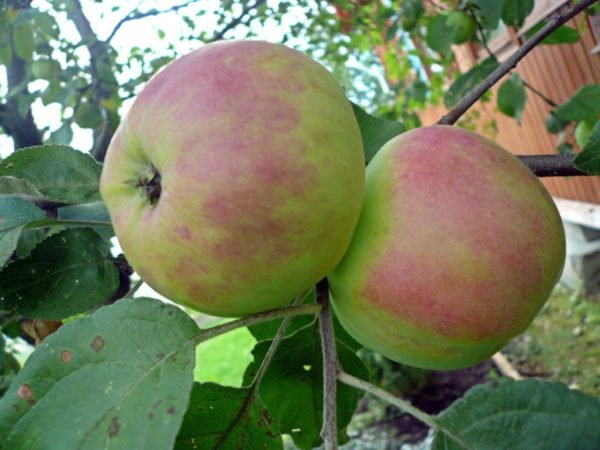
More than a hundred years ago, by pollination of two varieties: Yellow Bellefleur and Ordinary Chinese large-fruited, a hybrid form of this variety was obtained. The vaccine grafted on a mentor is adapted to severe climatic conditions. Due to the characteristics obtained, it is possible to grow a hybrid in any region.
The hybrid form consists of tall trees with a wide rounded crown, rich green foliage. Fruits in the stage of technical maturity differ in mass: most apples have 120-180 g, one fourth reaches 400-550 g. Some gardening enthusiasts specially grow this variety in order to use the largest fruits at exhibitions and regular marketplaces of wide importance .
During the harvest period - in the middle-end of September, the fruits of the hybrid have a pale yellow color. Within two to three weeks, the color of the apples changes to pale pink. Ripe fruits are juicy, sweet with a slight acidity. Planted apple trees yield the fourth year. Seasonal yield returns remain stable. Despite the presence of very large fruits, they never crumble from the tree even when damaged by pests and diseases. Distinctive properties:
- good taste;
- stable yield every year;
- ripening fruit too late.
Hero
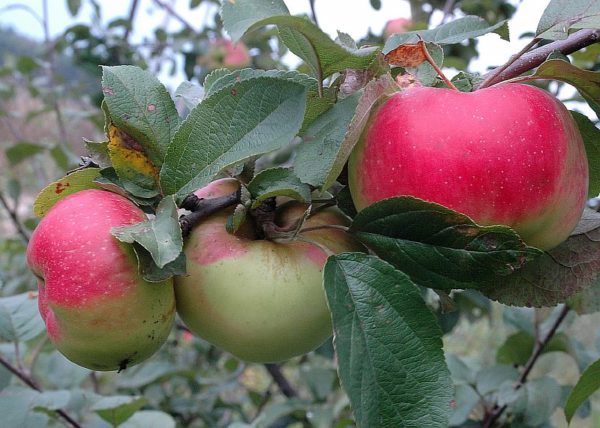
Late-ripening variety, bred about ninety years ago by the originating scientist S. Chernenko. To this day, autumn apples of this variety are harvested by fruit growers: Russia, Ukraine, Belarus and Moldova.
Trees of this variety grow up to 4-5 m. Its totality of all branches and leaves located in the upper part of the plant reaches up to 7 m in width. Fruits are formed mainly on short shoots with underdeveloped lateral buds. On one fruit branch, two to three apples are formed. Fruits have a rounded shape with a narrowed cup.In technical maturity, apples of this variety have a pale green color, fine-grained hard flesh of a snow-white color. The taste of fruits is sweet with a pronounced aroma. The weight of an average apple of this variety reaches 150-170 g, some fruits reach a weight of 350-420 g. Characteristic features:
- stable high yields every year;
- good transportability;
- preservation of presentation after prolonged storage;
- ugly light green color with removable maturity;
- a large percentage of damage to epidermal cells on the skin of ripe apples.
Bolotovskoe
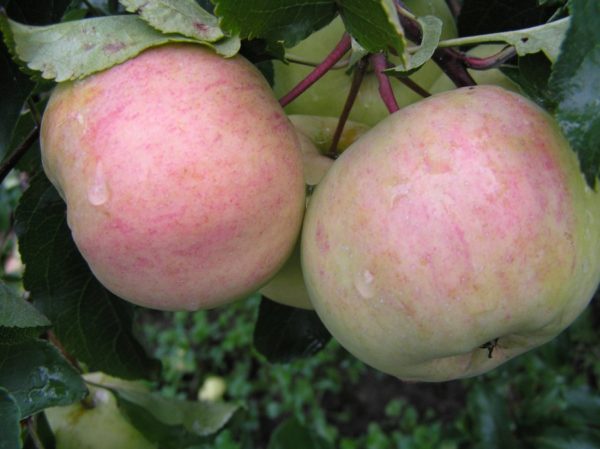
An apple tree, created at the selection center in 1977 by originators and honored scientists V. Zhdanov and E. Sedov. It is a hybrid form obtained as a result of two parental varieties: Skryazhapel and Abundantly flowering.
A fast-growing plant, reaching a height of 9-11m. It has a sparse, rounded shape of the upper branches and leaves and light brown shoots with a small edge. It forms a crop both on gloves and on skeletal growths. It has a stable high yield of productivity up to 145 centners per hectare. It does not have the ability to self-pollination, therefore, other varieties are needed nearby. The average weight of the fruit reaches 140-160 g. Harvesting begins depending on the region: in the second or third decade of September. During this period, the fruits have a yellow-green skin color, after storage, after three to four weeks, they turn into light yellow. Distinctive properties:
- good fruit quality even after prolonged storage;
- resistance to the pathogen Venturia inaequalis (scab);
- shedding of fruit during a delay in harvesting.
Gala
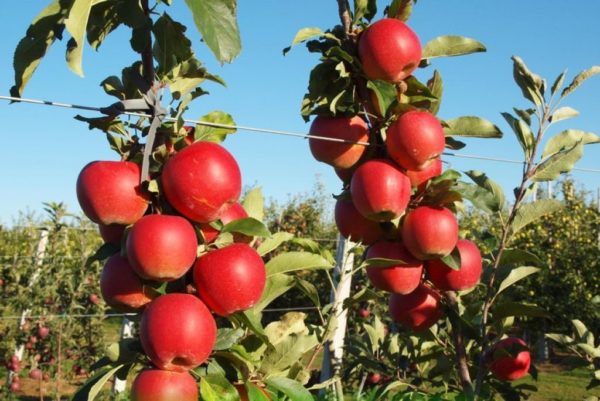
Late autumn species, its ploidy makes up two chromosomes, bred at the beginning of the seventies of the last century by amateur breeder D. Kidd. Obtained as a result of multiple crosses using seedlings of parental varieties.
A medium-height plant with a spreading oval crown and sparse tree-trunk branches. Resistant to short-term temperature drops, after prolonged frosts it starts to hurt. Forms uniform fruits of medium size, reaching a mass of 120-150g. The maximum weight of one fruit does not exceed 175 g. The shape of the apple is rounded with a small cone, weak ribbing. It has a yellow-green color, a solid juicy core, characterized by a sweet aftertaste with a slight acidity. Characteristics:
- unpretentiousness during cultivation;
- early ripening;
- high productivity.
- poor winter hardiness;
- uneven ripening;
- lack of presentation.
Grushevka
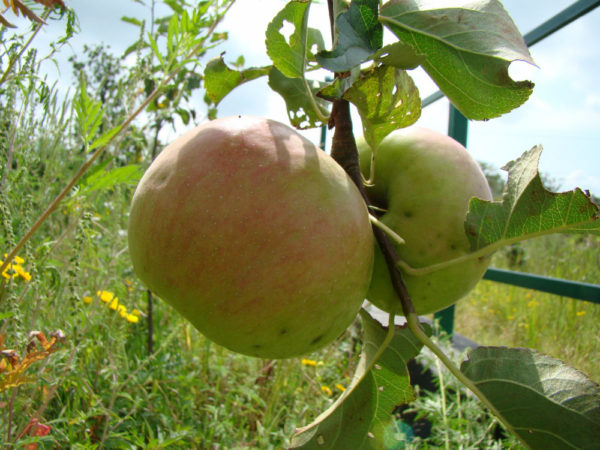
The best autumn apple variety from the existing rare ones. The plant, which has been known to botanists for more than 210 years, is described by the famous scientist and botanist of the eighteenth century A. Bolotov. Many gardeners plant a plant in their gardens in all regions of the former USSR.
Sprawling trees Grushevki reach a height of 6m-9m, subject to all agricultural practices, from the plant you can harvest up to 65 years. Its spherical crown is formed of densely leafy long branches reaching a length of 7.5 m.
The weight of one fruit in the stage of technical maturity is 50-75 g, the highest indicators of one apple are 125 g. The fruit is round-oval, narrowed to the apex, has a green-yellow color with small dots-moles. Differs in juicy pulp, sweet taste with a little astringency. Harvest ripens in the first or third decade of September, retains its qualities without loss of taste and presentation for three to four months. Distinctive properties:
- good winter hardiness inherited from "wild ancestors";
- quick adaptation and high survival rate of seedlings;
- high, annually increasing yields.
- non-simultaneous ripening of fruits.
Lobo
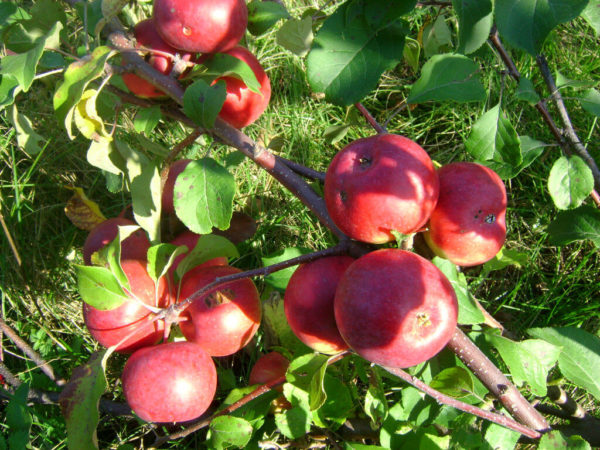
At the end of the last century, apple trees with an incomprehensible name began to appear in the gardens of Ukraine and Belarus Lobo. In the language of Mexicans and Americans, this word means "forest wolf", and seedlings arrived for the first time from the Canadian province, where they were bred by natural pollination using the Mekentosh variety. Its taste is so appreciated by Americans that it is included in the obligatory menu in schools and kindergartens.
Plants have an oval crown, medium growth power, actively grow in the first years after planting. Upon completion of growth, the apical part is rounded and becomes less frequent. Young seedlings have a cherry hue of shoots and large leaves of a rich green oval shape. The weight of one apple reaches 190 g, differs in a rounded elongated shape. Pulp - friable, white-yellow color of sweet and sour taste. The plant gives a fruit crop even after winters with an air temperature of -35 degrees. Characteristics:
- drought tolerance;
- high and stable yields;
- suitable product even for long-distance transportation;
- damage to fungal diseases with high humidity in the summer.
Long
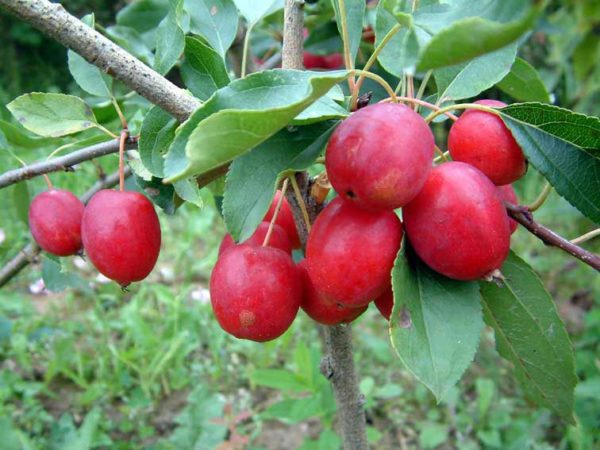
The culture created thanks to the work of American originators of the late fall maturity. According to the classification, it belongs to the group of wild sour apple trees.
A plant of medium height, reaching 6 m at the age of eight, is in some cases grown in the form of a tall shrub. It has a compact strongly leafy crown in the form of a pyramid, dark plum young branches with a light edge. The weight of one fruit reaches 12-18 g. The skin is matte light cherry in color with a touch of purple. The shape of the fruit is oval, resembling a miniature pomegranate. In the first or second September decade of the apple tree. Long reach removable maturity. Properties:
- resistance to scab;
- high frost resistance;
- decorativeness;
- not annual fruiting;
- short storage time.
Cinnamon striped
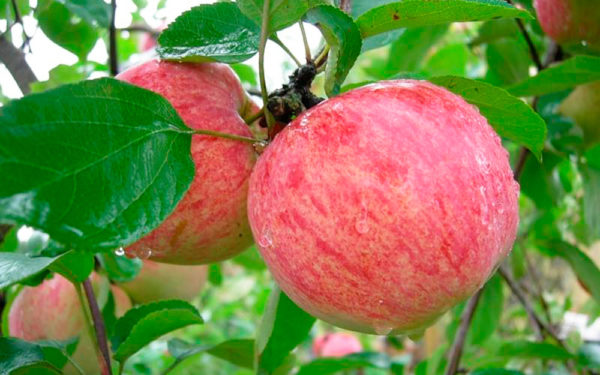
A rare variety of folk selection. The first mention of this plant dates back to 1800. Since then, the culture has not been improved by breeders, however, it has crossed with other species, starting 18 modern varieties.
Wood Striped cinnamon has a sprawling shape of all branches and leaves located in the upper part of the plant. Within five years after planting, the seedling directs all the power to build height. In the sixth-seventh year, the crown grows in breadth, becomes thick. The branches are very thin, practically do not grow in the lower part. This feature provides the variety with good ventilation and additional protection against damage by pathogens.
The fruits formed on last year's shoots have an average weight of 75–100 g, maximum - 160 g. They differ in a turnip shape, sweet taste of pulp with an aftertaste of cinnamon. Distinctive properties:
- winter hardiness;
- adaptation to adverse conditions;
- unique taste of fruits;
- instability to scab;
- harvesting only 6 years after planting a seedling.
Cinnamon new (September)
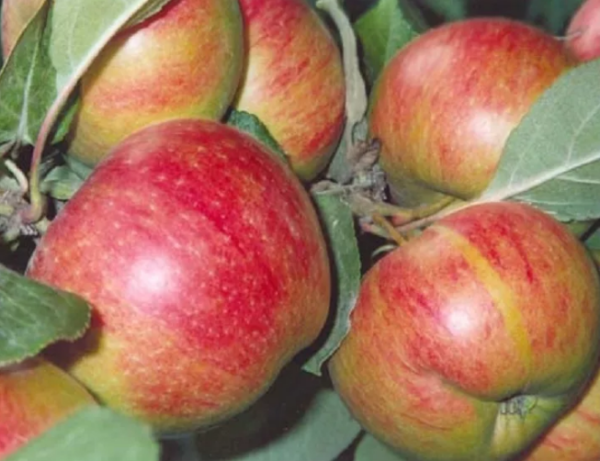
The author’s hybrid of the Russian originator S. Isaev, obtained by crossing two parental varieties: Welsey and Korichnaya striped.
The hybrid form refers to tall trees, being very viable. It has a densely leafy conical crown with sharp dark green leaves at the tips. The average yield of adult plants, subject to all agrotechnical measures, is up to 170-190 centners per hectare. The fruits of a round hybrid, narrowed to the apical part, reach a mass of 160-180 g. They have a dense yellow peel with pink-red uneven stripes. They have a pleasant aroma and dessert taste of pulp. Distinctive qualities:
- good transportability;
- resistance to damage by fungal spores;
- entry into fruiting only in the seventh year after planting.
Radiant
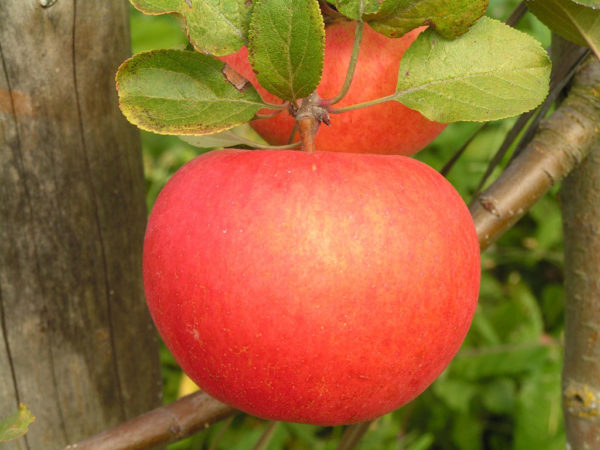
A hybrid form of Belarusian breeding, created fifty years ago at the Institute of Fruit Growing with the help of parental varieties: Banana and Lavfam. Favorable regions for hybrid cultivation are the southern and southwestern regions of the territory of the former USSR.
The plant has an average growth force, reaches a height of 4-5 m. It has straight, upward-growing branches, rarely located along the trunk. The bark of the stem of an adult tree of gray-brown color, the fruits in the stage of technical maturity are very large, reach a mass of 220–250 g. Each fruit has: the shape of a flattened ball with a small funnel in the center, delicate glossy peel, white-yellow sweet juicy flesh. After harvesting, the preservation of the fruit at a temperature of +6 - +8 degrees is three to four months. The first harvest takes place in the second or fourth year after planting a seedling. Characteristics:
- high productivity;
- weak scab lesion;
- good appearance;
- instability to damage by rot;
- short shelf life.
Macintosh (Khoroshevka, Autumn Red-sided)
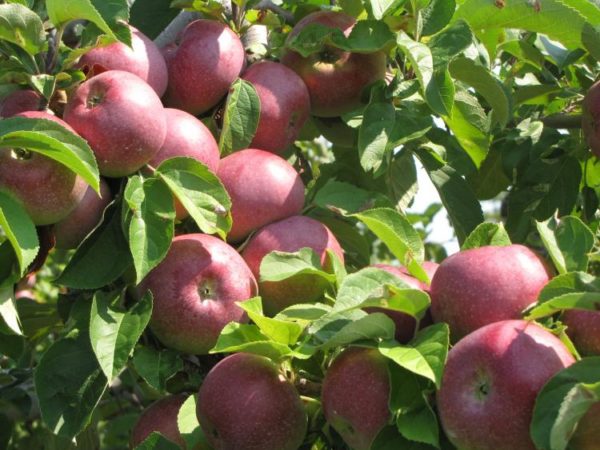
A tree with a Canadian pedigree, discovered by chance by a farmer D. Mackintosh in the eighteenth century. When buying a farm, the Canadian found in his plot a couple of dozen growing processes of unknown origin. After caring for the plants for several years, the farmer was able to preserve only one seedling, which bears fruit for about a hundred years. The surviving culture gave birth to new seedlings thanks to vaccinations, was named after its discoverer.
Macintosh trees are shaped like a sharp pyramid, reminiscent of an epiphany. Fruits grow in the wrong order, having different shades and structure. The fruit reaches 140–170 g, has a medium-large size, yellow-green color with abstraction purple spots. It has a rounded-elongated shape, narrowed to the apical part. It features a juicy fine-grained sweet inner part with a caramel aftertaste. Distinctive qualities:
- long life and fruiting;
- transportability;
- unusual caramel flavor;
- non-simultaneous ripening.
Oryol striped
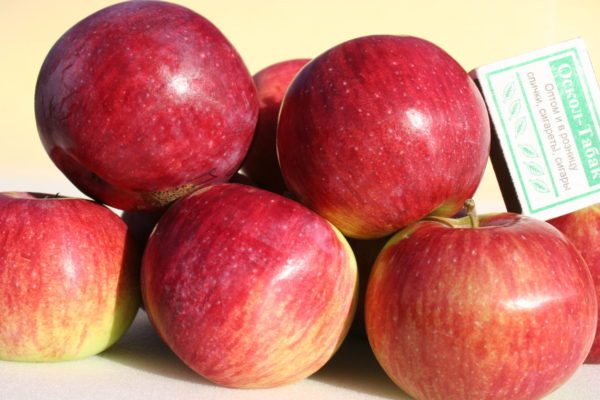
Late autumn hybrid, bred in the early sixties of the last century at the All-Russian Breeding Institute. It was born thanks to the cross-pollination of two parental forms: Mekintosh and Bessemyanka. Ten years later, the hybrid form was recognized as elite, recognizing the best of apple varieties for central Russia.
A medium-sized plant with a root system, letting the shoots deeper into only 2.8 m. It has a densely leafy round crown, with flexible branches. It features a large accumulation of ovoid foliage at the ends of branches. It has large fruits, reaching an average weight of 130 g, a maximum of 250 g. Each fruit has a turnip shape, elongated to the apex. In the stage of technical maturity, apples have a light orange color with blurry raspberry-red strokes. The inside is white-yellow, juicy, sweet and sour aftertaste. Harvesting of the Oryol striped begins in the first September decade, remaining at a temperature of no higher than +10 degrees until the New Year. Characteristics:
- early maturity;
- resistance to fungi Venturia inaequalis;
- short shelf life.
Memory of Isaev
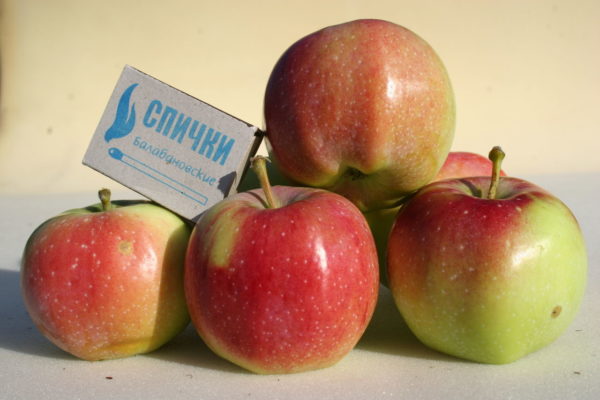
In memory of the breeder scientist S. Isaev, his follower students created a hybrid apple tree form by crossing the parental forms: Krasnobokaya Antonovka and SR 0523. The late autumn ripening hybrid was highly appreciated by gardeners in all regions due to its resistance to frosts of -40 degrees.
The trees of the Pamyat Isaev hybrid are characterized by active growth, reaching a height of 4.5–5 m. It has a round medium-leaved crown, large fruits of medium weight 170–210 g. With the correct formation of the crown, the maximum weight of the fruit reaches 300 g. The apple has a round slightly flattened shape and flesh, sweet with sourness, white and yellow. It has a delicate apple and peach aroma. Distinctive qualities:
- winter hardiness up to -42 degrees;
- resistance to the first to fourth scab race;
- increased productivity.
Pepin Lithuanian (Pepinka Altai)
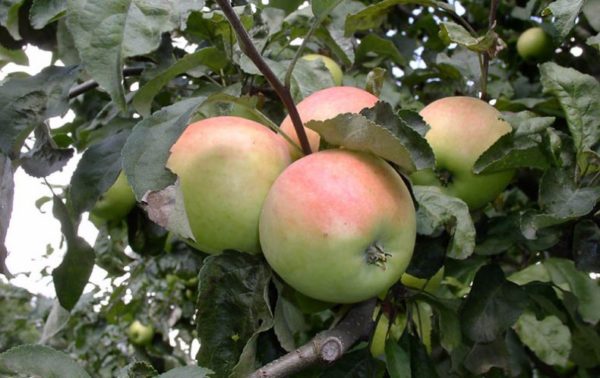
The culture that emerged thanks to artificial selection. At an air temperature not exceeding +4 degrees, apples of this variety are stored until the first days of February, are the best for soaking and salting in barrels.
Fast-growing medium-sized plants with a drooping densely leafy crown have winding gray-brown branches. The fruits are medium in size, have the shape of a round barrel of white-yellow color with a pink-red spot on the side, illuminated by sunlight. Harvesting begins in the first or second September decade, at a temperature of +8 - +9 degrees, they remain until the end of January. Features:
- improved early maturity;
- productivity;
- taste qualities;
- lack of resistance to pathogen damage.
Christmas
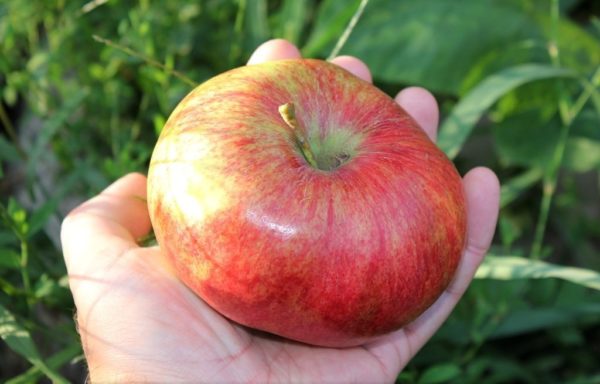
A young Russian variety, the originators worked on their cultivation: Z. Serova, V. Zhdanov, E. Sedov and E. Dolmatov.
Medium-sized tree, characterized by rapid growth. In the second or third year after planting a seedling, its growth every season is from 50 cm to 75 cm in length. Has a medium-sized crown, having the shape of a wide pyramid. It forms fruits weighing 130 g-190 g on annual growth branches. The maximum weight is 220 g. Apples have a dense glossy peel of light yellow color with a scarlet spot on the side and small gray specks, dense sour-sweet flesh. In the central and northern regions, they begin harvesting apples in late autumn. At the same time, their consumer period begins. Distinctive features:
- immunity to lesion of scabs;
- long shelf life;
- increased productivity;
- non-simultaneous maturation;
- shedding of fruits in strong winds and rain.
Sava
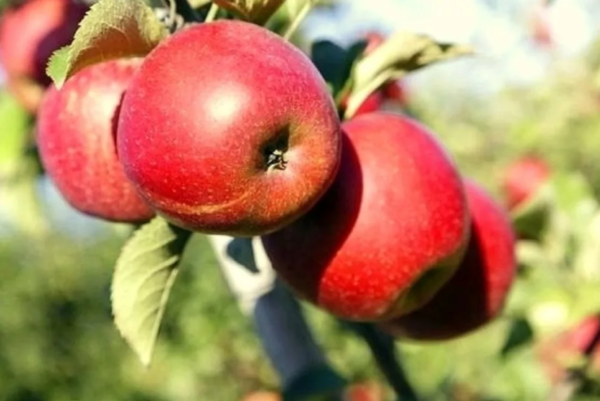
Moldavian autumn-winter dessert variety. Due to the loose juicy pulp, apples of this variety are considered the best for preparing baby food.
A medium-sized plant that begins to bear fruit 3-4 years after planting a seedling. The fruits are large, the average weight of one fruit reaches 160-180 g. They have a yellow-green color with blurry carmine-red stripes, creamy fine-grained inner part, thin skin. Fruits collected at the stage of technical maturity do not have a good presentation. After ripening at an air temperature of +10 degrees for two weeks, the color of the peel becomes bright, the apples acquire a beautiful appearance. At a temperature of +4 - + 8 degrees, they remain until the beginning of March. Features:
- resistance to temperatures below -30 degrees;
- resistance to scab, bacteria Erwinia amylovora;
- lack of a beautiful appearance at the time of removal.
Glory to the winners
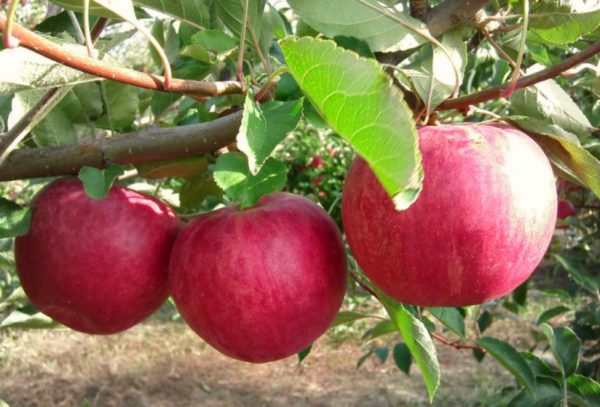
The hybrid form, created about a hundred years ago at the Ukrainian experimental station by the scientist-breeder P. Tsekhmistrenko using two parent varieties: Macintosh and Papirovka. The plant took the best qualities from its parents, becoming popular not only in the territory of the former USSR, but also abroad. Adapts to various climatic conditions, growing in all regions.
A vigorous hybrid has a powerful sprawling apical part of the shape of a wide pyramid, which after six to seven years transforms into an oval. In areas with a cold climate, harvesting falls on the first days of September, warm - two weeks earlier. The hybrid form is distinguished by the formation of medium-large fruits weighing 150–210 g on ringworms and annual branches. The fruit has an oval shape with light corrugation, a dense peel, a yellow-white juicy pulp. Apples Glory to the winners is distinguished by a pronounced aroma, sweet and sour taste. Characteristics:
- marketable condition;
- resistance to frost;
- pronounced aroma;
- discharge of fruit with lack of moisture.
Spartan
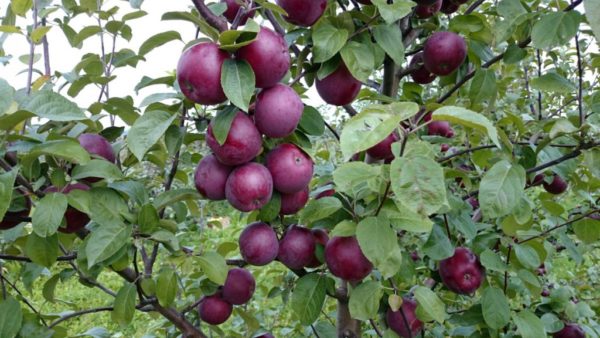
Canadian high-yielding hybrid bred in the process of cross-pollination of two parent varieties. Due to the urgent need to obtain a hybrid form of apples, which would differ in its presentation and long shelf life, Canadian breeders created Spartan, which was introduced to the USSR thirty years ago. Suitable for cultivation in the central and western regions.
The hybrid is characterized by active growth, growing to 5-7m. When all the necessary agricultural practices are carried out, it begins to bear fruit in the second or fourth year after planting, increasing yield with each season. Gardeners get 20-30 kg of apples from a seven-year-old tree. It has small dark green leaves, round-shaped fruits of yellow-red color. The average weight of one fruit is 130-150 g. Despite this weight, the apples hold firmly on the stalk and do not crumble even after a strong wind. Distinctive properties:
- annual fruiting;
- good transportability;
- storage up to eight months;
- instability to frost more than -28 degrees.
Teremok
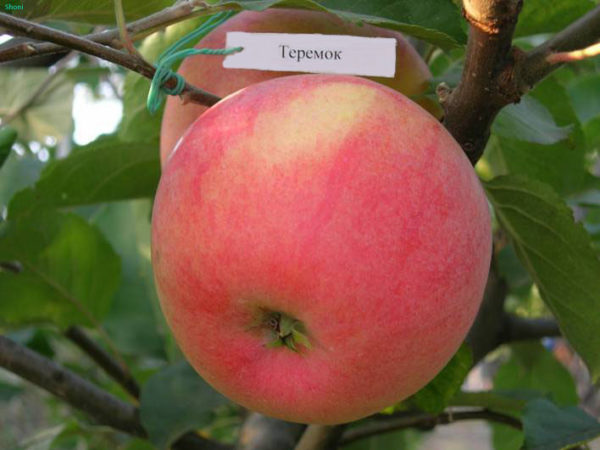
The hybrid form of apple trees, developed by Ukrainian scientists, the initiators of the Institute of Horticulture V. Kopan and K. Kopan by crossing two hybrids: Griev Rouge and 25/2-D. The resulting form of apple trees is not resistant to severe frosts. However, the presentation of the fruit and undemanding care made the apple tree a favorite of many gardeners living in the southern and southwestern regions.
Teremok is a medium-sized tree with a round, not dense crown. The weight of one fruit of a conical shape reaches 190-210 g. The fruits have a peel, it has an orange-red color, a juicy dense pulp of a sweet and sour taste. Characteristics:
- early maturity;
- good presentation;
- resistance to fungal diseases;
- damage to the kidneys at a temperature of -25 degrees.
Uralets
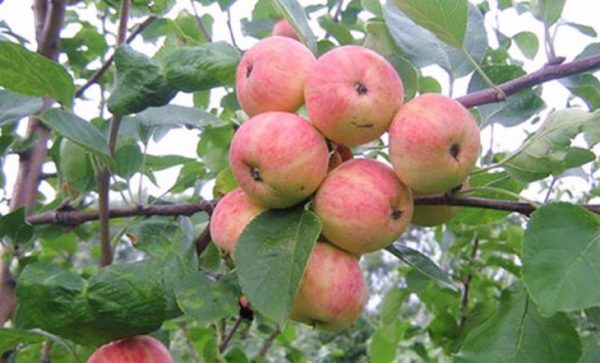
A variety that was developed by the Ukrainian agronomist P. Dibrov about 150 years ago. Working at the Sverdlovsk horticultural breeding station, the breeder gathered valuable seedlings, crossing them, getting new varieties and hybrids. After cross-pollination of three varieties: Striped Anise, Saratov Ukrainian and Wax Chinese, the Uralets appeared.
The tree has a wide trunk and a height of 10 m, a wide pyramidal top. The average weight of one fruit is 45–55 g. The fruit has the shape of a cone with a truncated apical part, a light brown skin with raspberry stripes. The flesh is a pale yellow color, juicy sweet and sharp taste. Distinctive qualities:
- resistance to pathogens and viruses;
- not a long shelf life.
Delight
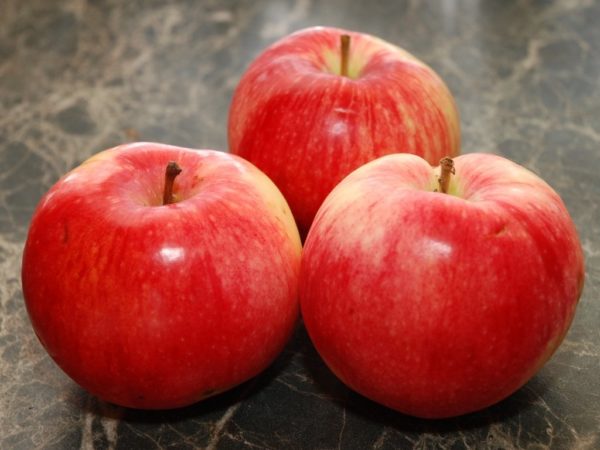
The variety, known to gardeners in the central Russian regions, was bred about fifty years ago by the selection scientist S. Isaev. Having crossed the wild apple trees with the cultivars Narodnoye and Severyanka, the originator received a new variety with very tasty fruits.
The tree has a fast growth rate, reaching a height of 5-6 m, has a dense crown that needs to be trimmed in the form of a ball.The average weight of one fruit reaches 110–140 g, the maximum - 180 g. The peel of the apple is a dense salad-green color with an orange-red covering blush. The pulp is pink-white, dense, juicy, has a sweet taste with a slight acidity. Distinctive qualities:
- frost resistance;
- resistance to scab;
- the need for crown formation.
Champion
A hybrid form of Czech selection obtained in 1970 at the Experimental Station when two parent varieties were crossed: Golden Delishes and Orange Renet. The hybrid immediately gained popularity among gardeners on the European continent.
The hybrid tree is compact, and its height depends on the plant variety on which the stem with a kidney is grafted. In the event that the seedling on which the dwarf cuttings is rooted, the Champion will proclaim the next year after planting. It has very large fruits, reaching 180-210 g. Light green in color with orange-red stripes blurred throughout the apple. Characteristics:
- early maturity;
- good presentation;
- annual fruiting;
- medium resistance to frost and bacterial burn.
Varieties for the Middle Volga
The territory adjacent to the Volga is characterized by a temperate climate. To grow fruits in these regions, you need to consider the characteristics of the culture. Description of varieties and hybrids with photographs suitable for the Middle Volga region will help to choose a seedling.
Anise scarlet
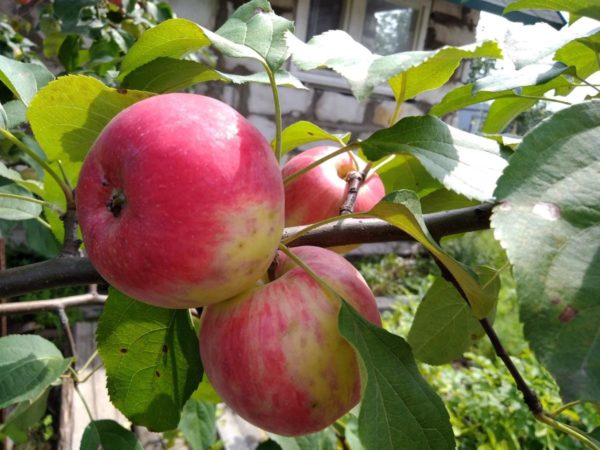
A rare species that arose due to artificial selection, grown in the gardens of Russians for about 150 years. Obtained by natural cloning of a similar variety.
A vigorous culture with a non-sprawling apex in the shape of a ball Turnip-shaped corrugated fruits have a light green color with a coating of waxy substance, reach 110-125 g. The inner part is juicy, acidic with a low sugar content. Features:
- beautiful appearance;
- the ability to transport over long distances;
- instability to causative agents of Venturia pirina.
Anise striped
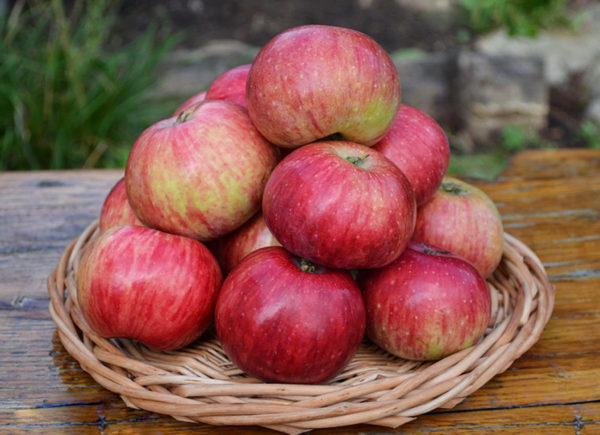
A new species, which appeared due to artificial selection in the Volga gardens more than 200 years ago. Autumn apples, which are grown not only in personal plots, but also on an industrial scale. The large "cloned apple Anis family" was used by originators to breed new hybrids.
The plant has a pyramidal mid-leaf apical part, which in 8-10 years grows in breadth. It begins bearing fruit for the fifth season. The mass of one fruit reaches 110-130 g. A smooth peel is covered with a layer of wax and bright raspberry blurry strokes. The inside of the sand color, medium grain, sweet. Distinctive features:
- stress resistance;
- irregular fruiting;
- frequent damage by peronosporosis.
Antonovka ordinary
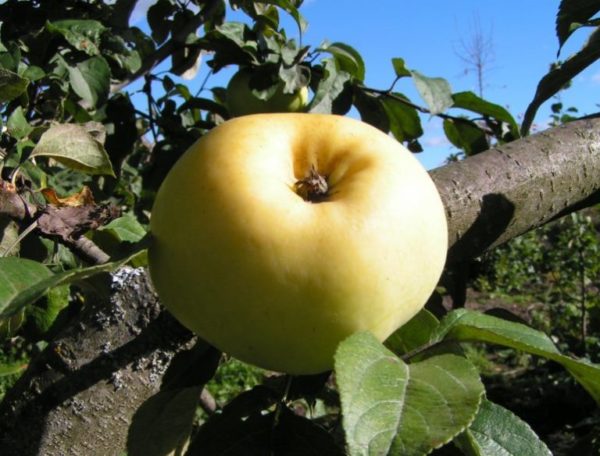
The culture, which appeared due to artificial selection, has been grown on its sites by gardeners of Russia, Ukraine, Moldova and Belarus for more than a hundred years. It owes its appearance to amateur fruit growers who created a new look through the pollination of wild and cultural forms.
The plant has an oval apical part, transforming after 8-10 years into a spherical. Fruits in the stage of technical maturity are distinguished by a yellow-green color, ribbed shape, weighing 285-335 g, creamy flesh to taste. After storing the ripened apples for a month, the aroma intensifies several times, the sugar level rises. Characteristics:
- the fitness of apple trees to grow in different regions;
- high productivity;
- resistance to diseases and frosts;
- not long storage.
Arkad Tenkovsky
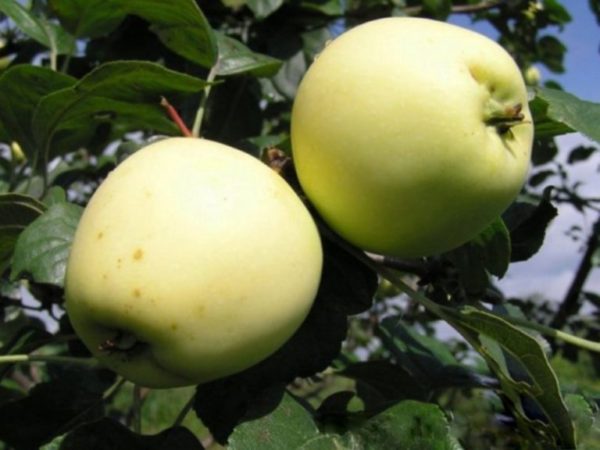
The apple tree, which was brought out by transferring pollen from the anther on the stigma of a pistil, agronomist G. Rozanov.Grown by gardeners of the Middle Volga for more than 60 years.
A medium-sized plant with a densely leafy conical apex. It has conical corrugated fruits weighing 95-115 g. It is distinguished by a thin pale yellow glossy peel without a waxy coating. Distinctive properties:
- ability to withstand long haul
- medium immunity to damage by fungal spores and infections;
- the need for background pollination.
Bashkir handsome
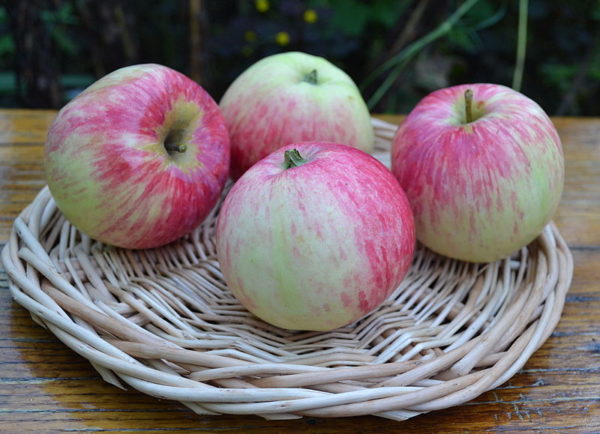
A rare variety obtained after the natural pollination of wild and cultural forms.
The culture is not distinguished by an active growth force, it has a pyramidal mid-leaf apical part. Fruits reach 80-100 g. When processing trees throughout the season with complex fertilizers, the weight of the fruit reaches 145-165 g. It differs in a rough, glossy skin with a coating of waxy substance. The snow-white interior has a sweet-sour taste with bitterness. Features:
- increased productivity;
- storage 5-6 months;
- resistance to pathogens and viruses.
Borovinka
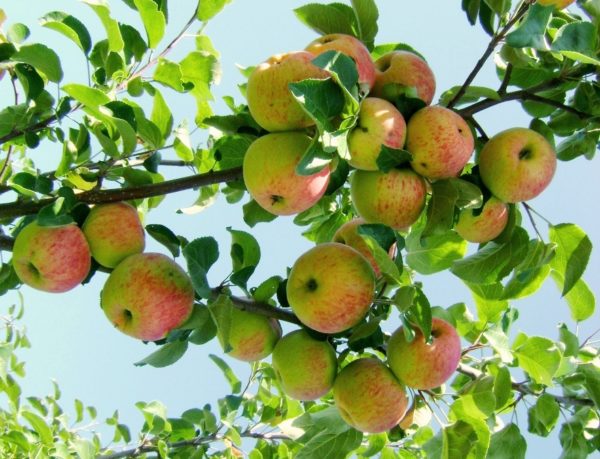
An ancient variety obtained as a result of natural pollination of wild and cultural forms. According to one version, the apple tree was named after a gardener from Tula Boravin, who was engaged in the cultivation of new plant species.
The medium-sized plant, reaching a height of 6.5-7.5 m at the age of 15 years, has a rounded slightly leafy apex. It differs in spherical fruits reaching 195-255 g. On the shiny shell are pink-red asymmetric stripes and small specks. The subcutaneous part is dense, sweet with a slight acidity. After storing apples for 20-35 days, the acid content is reduced, the pulp becomes sweet. Distinctive qualities:
- undemanding to leaving;
- high stable yields;
- resistance to frost;
- falling of ripe apples in strong winds and rain.
Bessemyanka Michurinskaya
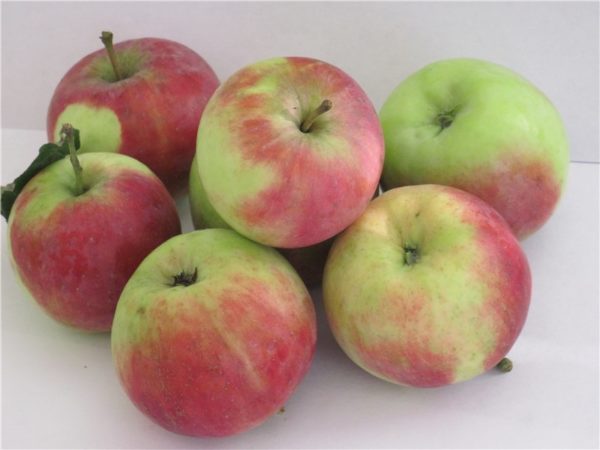
The hybrid form obtained by I. Michurin when crossing two species: Komsinskaya Bessemyanka and Skryzhapel. It is widespread both among amateur gardeners, and at grape-gardening enterprises.
A tall crop with a wide round apex has a few powerful lignified shoots. Fruits above average sizes, reaching a mass of 225-255 g, are distinguished by a round symmetrical shape, glossy skin of light green color with a red blush. On the peel there is a coating of waxy substance. The subcutaneous part of the light yellow color has a sweet-sour dessert taste, pleasant aroma. Characteristics:
- improved product quality;
- annual harvest;
- crumble of ripe apples in a strong wind.
Volga beauty
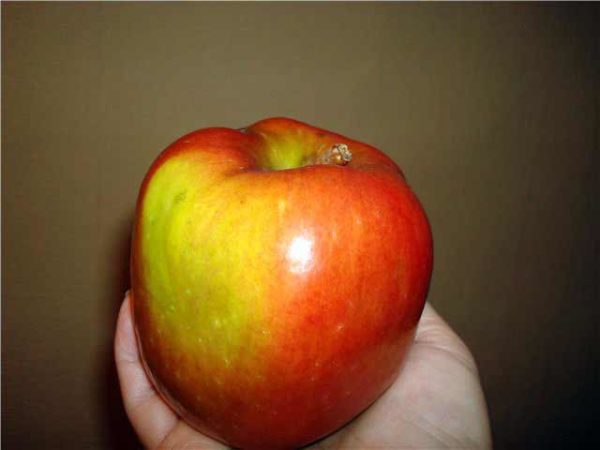
The late autumn hybrid, bred by the scientist-originator I. Rozanova, when two parental forms were crossed: Krudner rennet and Borovinka. Preserved without loss of taste until the first days of March, are the best for home and industrial preparations.
The tree is distinguished by active growth power, a round densely leafy top. Fruits reach a mass of 135-185 g, have a flattened-round shape. The peel of the fruit is a dense yellow-cream color with pink-scarlet asymmetrical stripes. The snow-white interior is characterized by a dessert aftertaste. Distinctive qualities:
- long shelf life;
- transportability;
- immunity to marsupials Venturia inaequalis;
- the need for pollinating apple trees.
Zhigulevskoe
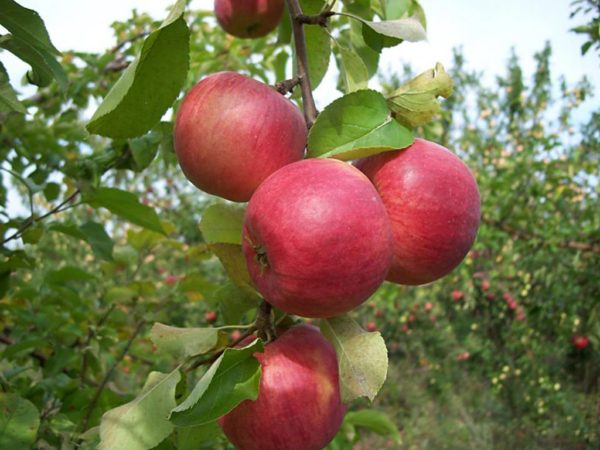
A hybrid obtained by Samara originators as a result of the scion of parental varieties on a mentor.
A fast-growing plant with a rounded apical part. Harvesting begins in the third or fourth season, and falls at the end of September. It differs in fruits, reaching 245-325 g. Corrugated spherical shape.The shell is thin light green in color with blurry red rims. The subcutaneous part is light yellow, soft, harmonious honey taste. Distinctive qualities:
- stable yield;
- resistance to actinomycetes and bacteria;
- short shelf life;
- freezing of shoot primordia during spring frosts.
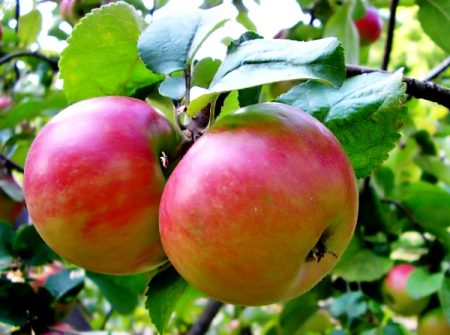 You may be interested in:
You may be interested in:Zaryanka
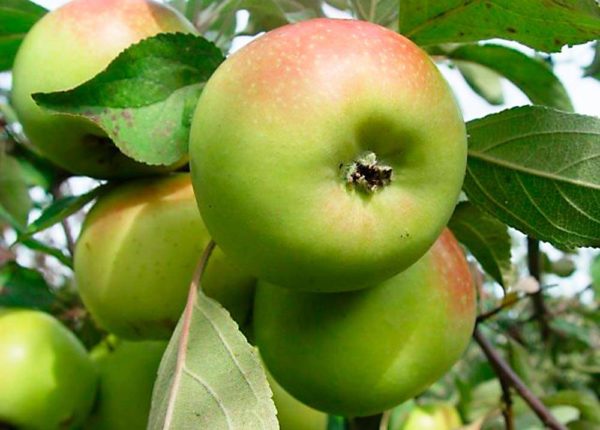
A hybrid with a gene carrier of disease resistance created by Russian breeders when crossing parental forms.
A hybrid culture having a round middle leaf top. The fruits of medium size, reaching 125-145 g have a round flattened corrugated shape. The glossy shell is yellow-green with red-pink asymmetric stains. The subcutaneous part is light yellow, dense, juicy, tastes like homemade wine. Characteristics:
- beautiful appearance;
- resistance to pathogens and viruses;
- shedding fruit with a delay in picking.
Fiancee
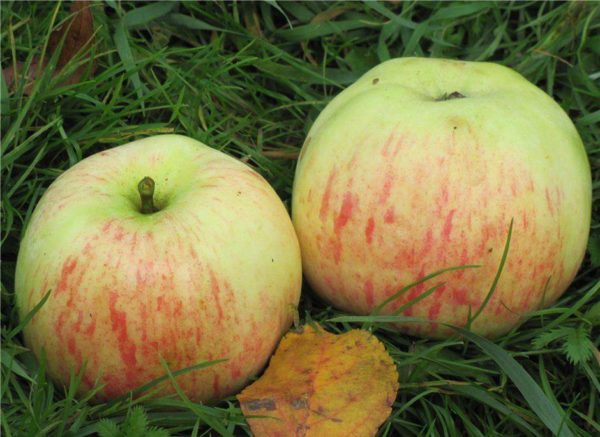
The hybrid form obtained by Russian organizing scientists as a result of pollination of two parent varieties. Recommended for cultivation in the central and eastern regions.
The plant is characterized by moderate growth force and slightly leafy apical part. Fruits are large, reaching 180-280 g have a round slightly corrugated shape. On the light yellow shell of apples, red strokes of different widths, brown specks are arranged in the wrong order. The inside is dense, juicy sweet and sour taste. For good fruiting requires planting pollinators. Distinctive qualities:
- crown strength;
- short shelf life.
Lyubava
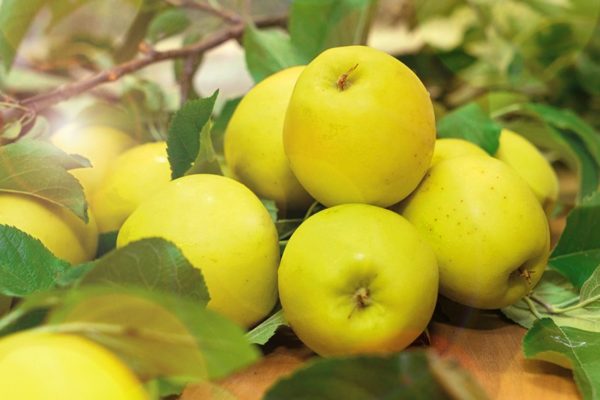
Late autumn hybrid bred by Krasnoyarsk breeders by cross-pollination of two parent varieties. It bears fruiting in the eighth to ninth year after planting.
A vigorous crop has medium leaf. The fruits of Lyubava are round, not large, reaching a mass of 55-75 g. The skin is light green, dense. Snow-white pulp is distinguished by juiciness, dense structure, wine sweet and sour taste. At a temperature of +6 - +10 degrees, apples are stored until March. Characteristics:
- winter period of use;
- scab resistance;
- resistance to reduced rainfall.
Autumn Striped (Streifling)
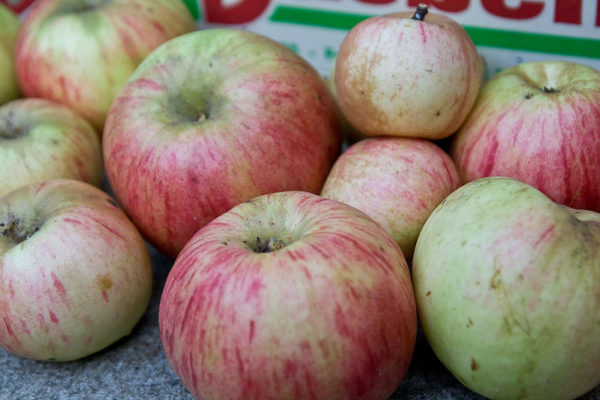
A rare Baltic variety that has been pleasing gardeners to the territory of the former USSR for many years. It is one of the favorites among fruit growers of the Middle Volga region.
The tree has a high growth rate, a funnel-shaped crown with drooping powerful branches. The fruits are medium-sized, unequal, corrugated, weighing 235–315 g. The peel of the fruit is shiny, thin with a touch of waxy substance, it has a yellow-green color with orange stripes. It begins bearing fruit in the ninth year, however, adult plants bring high yields. Features:
- good yield of adult trees (up to 250 kg per plant);
- poor drought tolerance.
Autumn joy
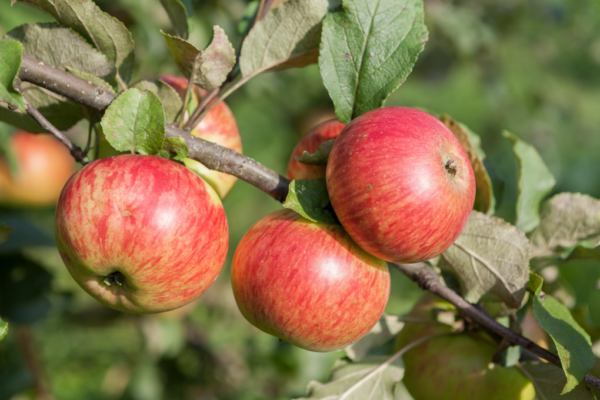
The second-generation hybrid obtained by breeder I. Isaev from crossing two promising parental forms. Thanks to the hard work of the scientist, an apple tree appeared with increased early maturity and productivity.
A vigorous plant with a thick oval crown growing in breadth ten years later. Apples in technical maturity reach a mass of 115-145 g, have a round-conical shape. the shell is yellow-green in color with raspberry-red strokes and gray subcutaneous mottles.The subcutaneous part of the yellow-white color has an average density of the structure, a sweet taste with an acidity, with the aroma of cinnamon. Distinctive qualities:
- frost resistance;
- abundant annual crop;
- scab resistance;
- fragile wood in young seedlings.
Ural bulk
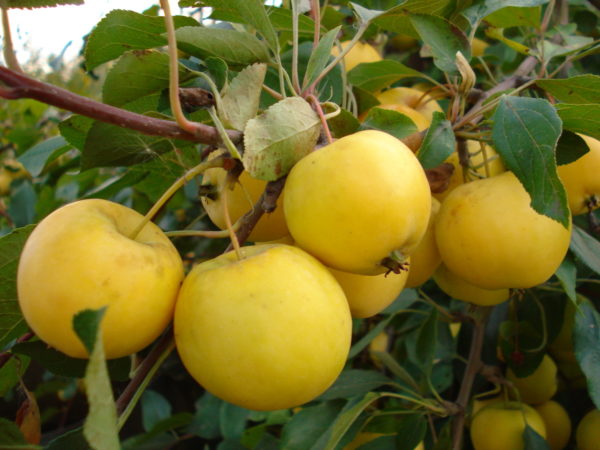
The hybrid, obtained thanks to the originating scientist P. Zhavoronkov when crossing parental forms: Papiroka, Red ranetka and Uralskoe. The resulting apple tree tolerates spring frosts well, begins to bloom in late May.
The medium-sized tree has a thick, round, drooping apical part. The apples are small, reaching a mass of 65-85 g. They have a glossy yellow-green peel, dense juicy sweet and sour flesh. The crop begins to bear fruit early, differing in productivity up to 260 kg from one tree. Features:
- adaptation to any cultivation conditions;
- transportability;
- small fruition.
Wellsie (Abundant, Tartu Rose, Harvest)
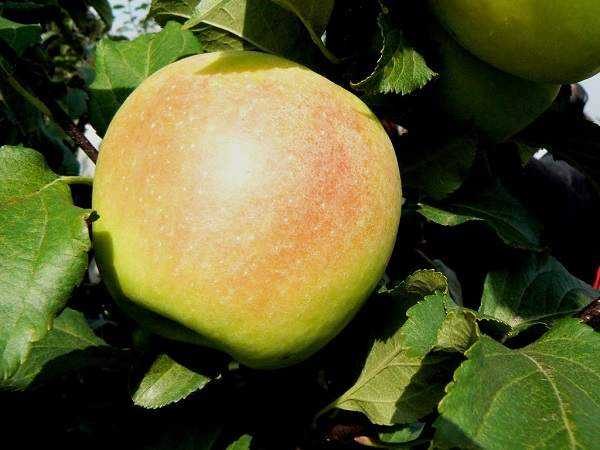
Variety with an American pedigreewho arrived in Russia at the end of the nineteenth century. Thanks to its advantages, the apple tree has been a favorite of most gardeners around the world for 150 years.
Mid-sized tree, whose height depends on the mentor. On dwarf rootstocks it grows up to 3 m, on tall ones - up to 6 m. The average weight of one fruit is 95–165 g. It has a round symmetrical shape, a shiny yellow-green peel, which is covered with a red blush when technical. The pulp is sweet with a pleasant acidity, firm and crisp. Subject to temperature conditions, apples are stored until the beginning of February without loss of taste. Distinctive qualities:
- winter hardiness up to -26 degrees;
- transportability;
- immunity to fungal diseases;
- the dependence of taste on climatic conditions.
Young naturalist
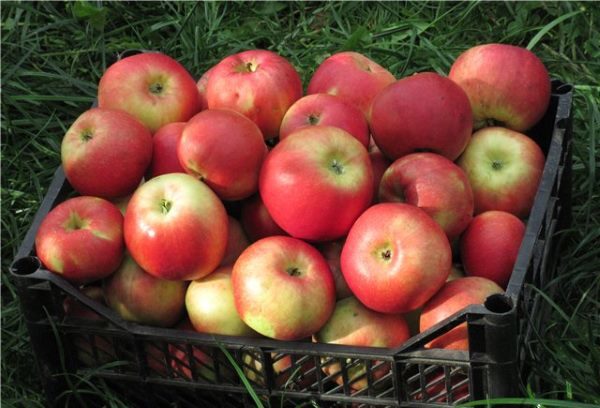
A hybrid that was born thanks to the crossing of Cinnamon Autumn and Welsey, as well as the hard work of the breeder S. Isaev. Favorite variety of many gardeners in the Middle Volga.
A tree with an active growth force and a round densely leafy apical part. It has medium-sized rounded fruits weighing 125-155 g. Raspberry-red strokes and numerous small subcutaneous dots are placed on the yellow-green shiny skin. The flesh is light yellow, juicy, medium-dense, sour. Features:
- high winter hardiness;
- resistance to lesion by scab;
- fruiting frequency.
Varieties for Moscow Region
The climate of the Moscow region is characterized by harsh winters, hot rainy summers. To select apple seedlings for planting in this region should be, taking into account all the features. Most Popular varieties for Moscow region with a photo and description, they will help you learn about the characteristics of each species, choose the best one.
Gordeevskoe
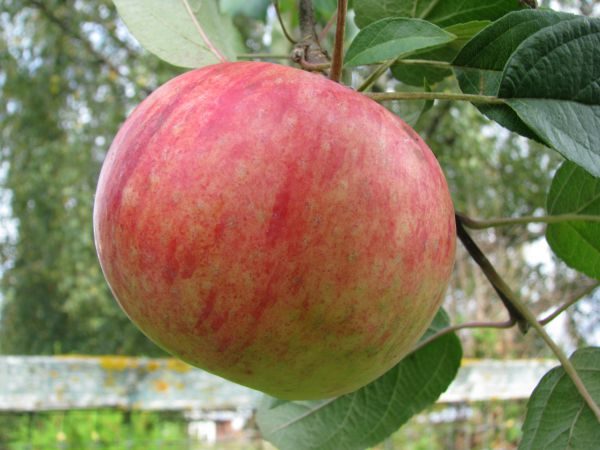
A variety that is the result of the work of breeders-scientists of the All-Russian Institute of Horticulture and Nursery. According to available characteristics, many gardeners call him the "youngest son" of Mack.
Medium-sized plant with a round slightly leafy top, fruits weighing 125-145 g of a round symmetrical shape. The fruit shell is light green with scarlet tinted sides. The inside is snow-white, crispy, sweet with a sour taste. Distinctive features:
- fruiting in the seventh year;
- immunity to pathogen damage;
- shedding fruit when tightened with harvesting.
Muscovite
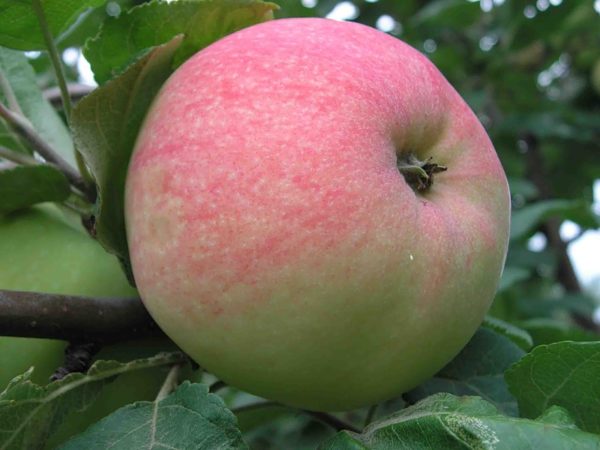
A hybrid apple tree, bred by crossing two parental forms: Isaevsky dessert and Melba. The resulting species is more resistant to Venturia inaequalis marsupials than its parents. It also withstands frosts down to -39 degrees.
The fast-growing mid-growth tree has a round mid-leaf apical part.It differs in medium-sized fruits, reaching 145-205 g of a broad-conical ribbed shape. The peel has a white-green color with a light red blush on all sides of the apple and numerous small specks. The inside is juicy, medium density, sweet harmonious taste. Characteristic qualities:
- resistance to the three races of scab;
- not requiring the formation and trimming of the crown.
Oryol pioneer
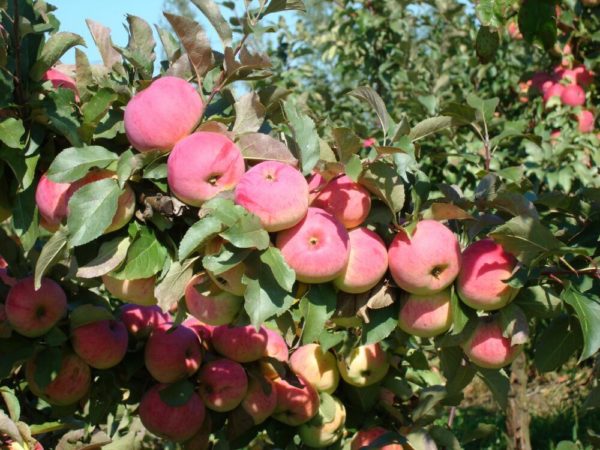
The hybrid form obtained by cross-pollination of two varieties: SR 0523 and Antonovka. After passing the tests at the Institute of Breeding, it is recommended for cultivation in central areas.
Trees of medium vigor have a round crown of medium density. Medium-sized fruits weighing 125-165 g have the shape of a turnip, glossy dry pale yellow skin. On most of the peel is a blurred blush of raspberry colored strokes not the same size. The white-green core is juicy without a pronounced aroma. Distinctive features:
- increased immunity to the four races of scab;
- good presentation;
- fruit size reduction during overload.
Autumn Susova
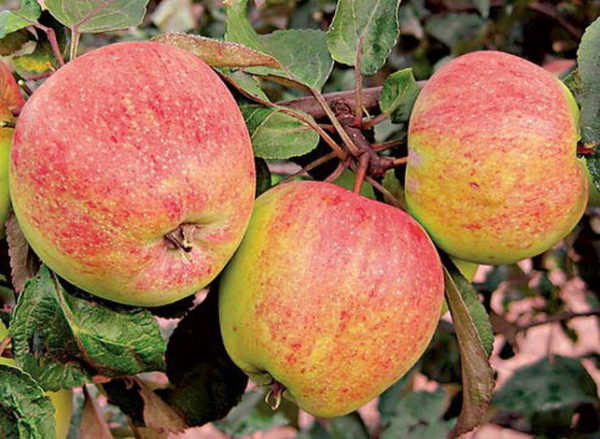
A variety that does not have a precisely identified genetic origin. Selected among the best seedlings about thirty years ago, the originating scientist V. Susov. After the tests, the plant proved to be a promising apple tree, recommended for cultivation in: Moscow, Vladimir, Ivanovo, Tver, Tula, Yaroslavl regions.
A medium-sized plant with a round spreading crown. It is distinguished by fruits reaching a mass of 105-125 g of an elongated symmetrical shape with a weakly pronounced ribbing. The yellow-red dense peel has no subcutaneous moles. Snow-white pulp juicy medium density sour-sweet wine taste. Characteristic properties:
- increased yield;
- relative resistance to the Venturia inaequalis genome;
- frost resistance.
Before you buy your favorite apple seedling, you should carefully study the hybrid or variety. A purchased apple tree should be suitable for all characteristics for the region where it will grow.

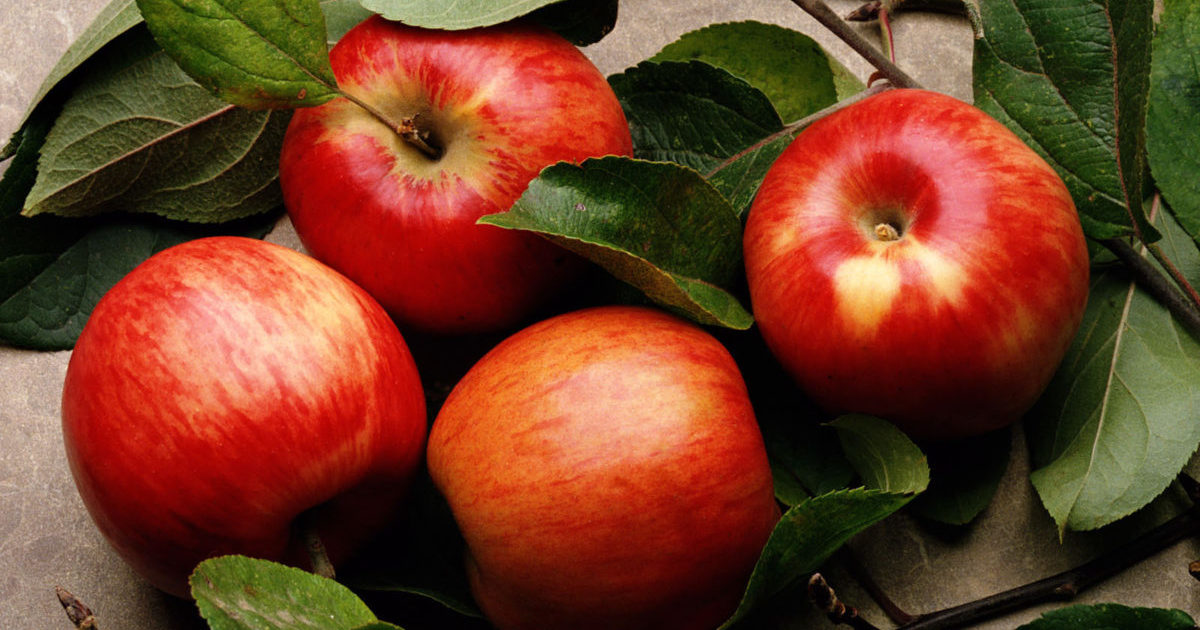
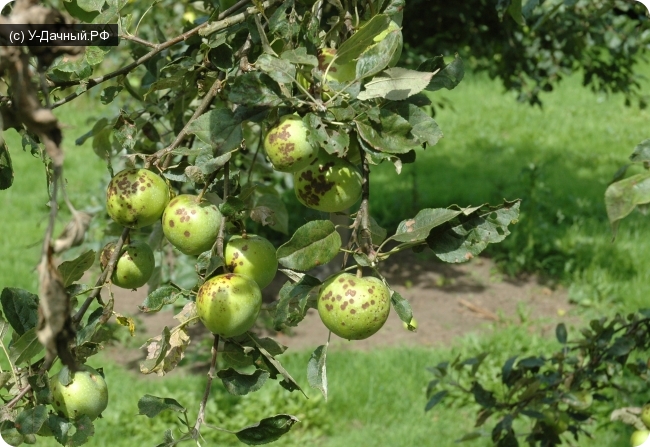
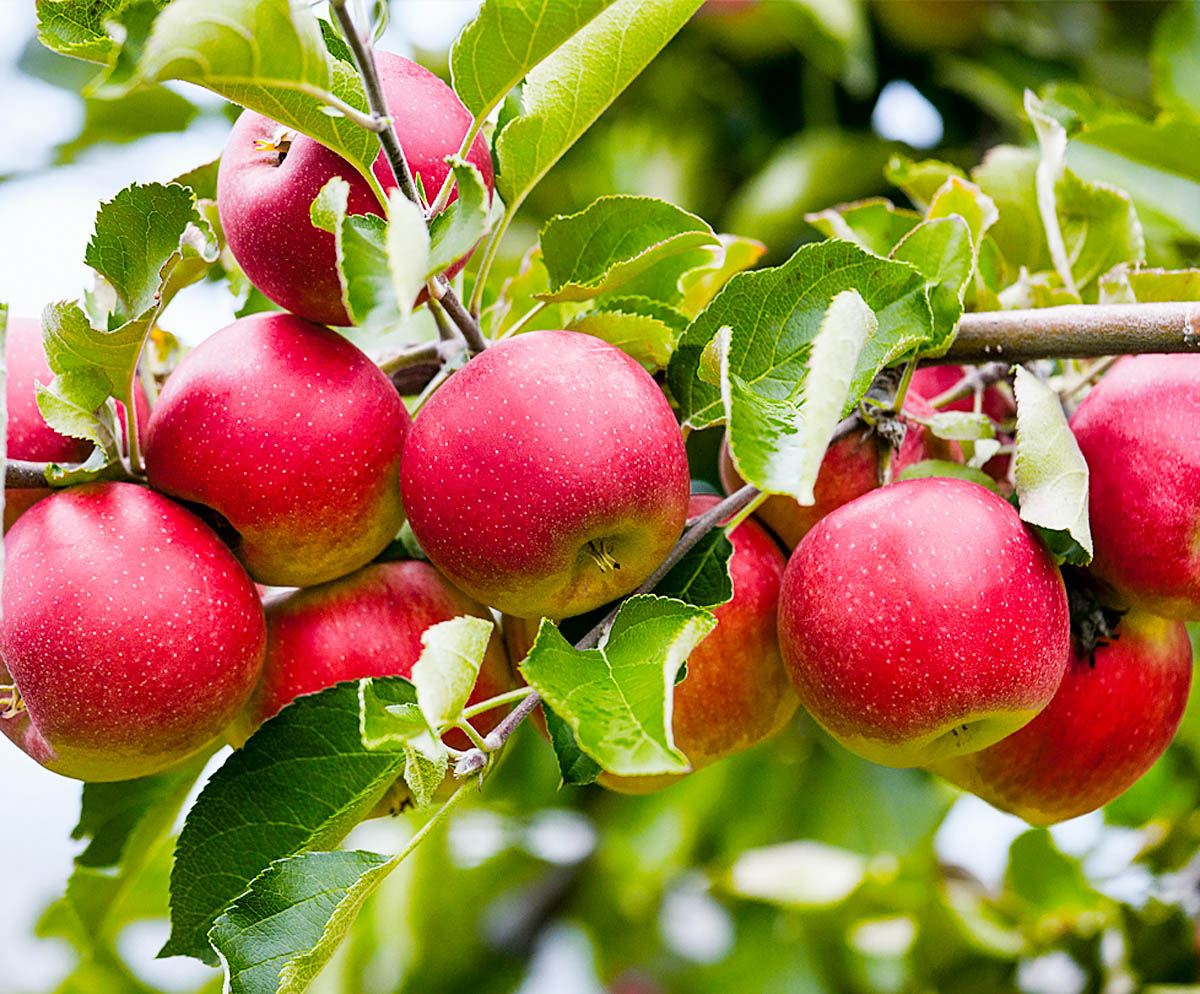
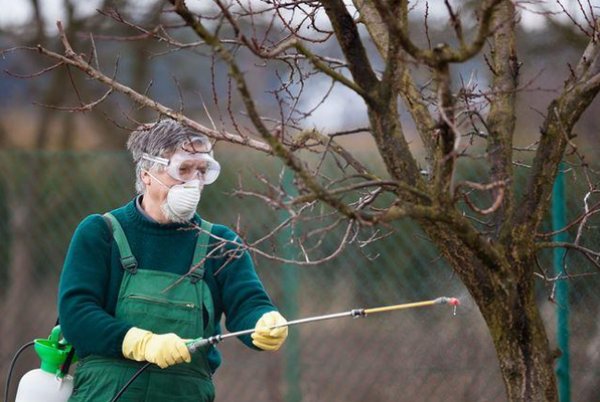 Autumn processing of apple trees from pests and diseases: how to spray, terms
Autumn processing of apple trees from pests and diseases: how to spray, terms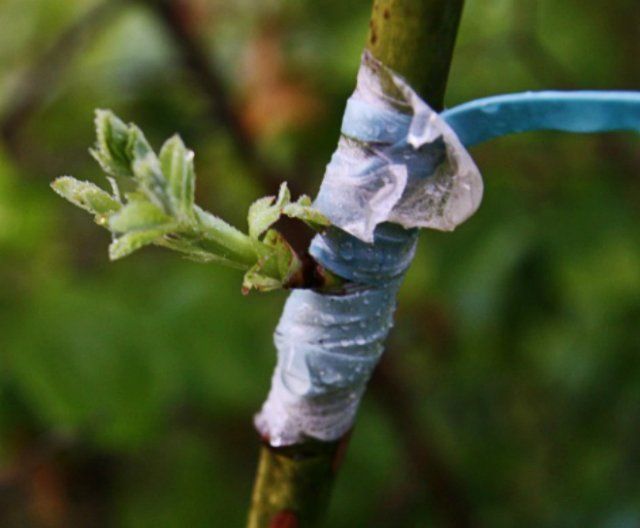 How to plant an apple tree in the fall
How to plant an apple tree in the fall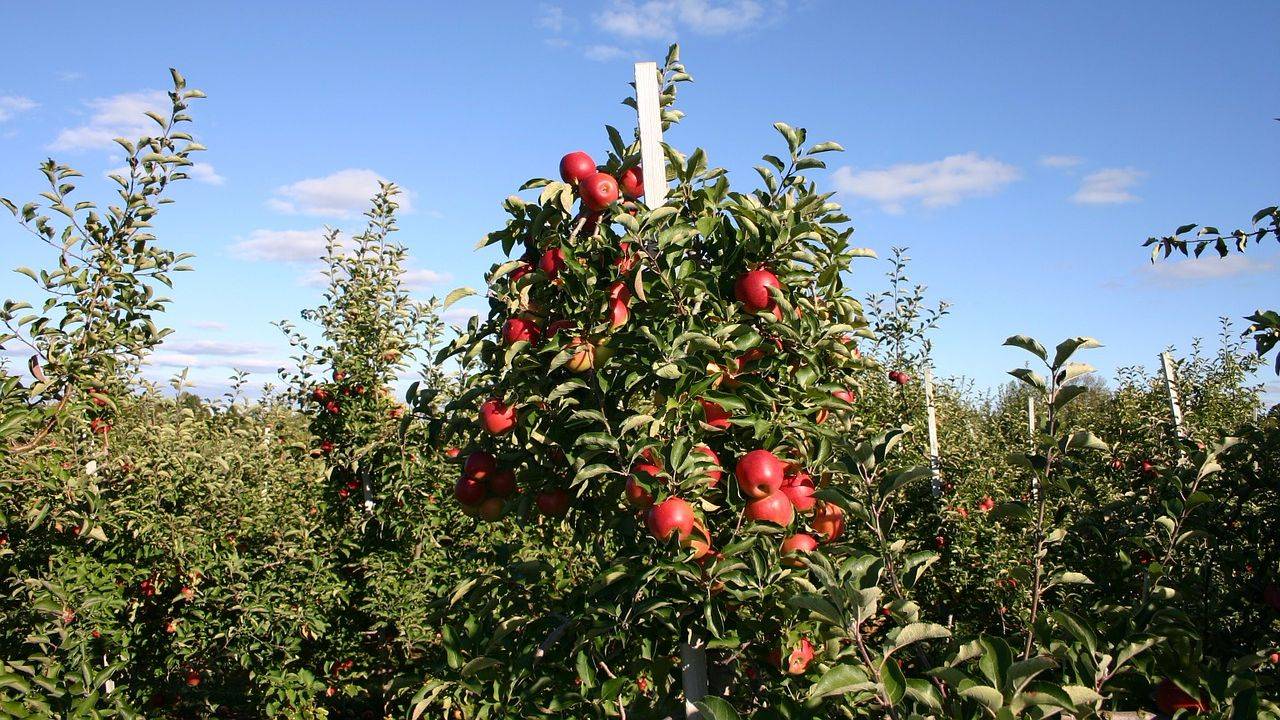 How to prune a columnar apple tree in autumn: features, timing, patterns
How to prune a columnar apple tree in autumn: features, timing, patterns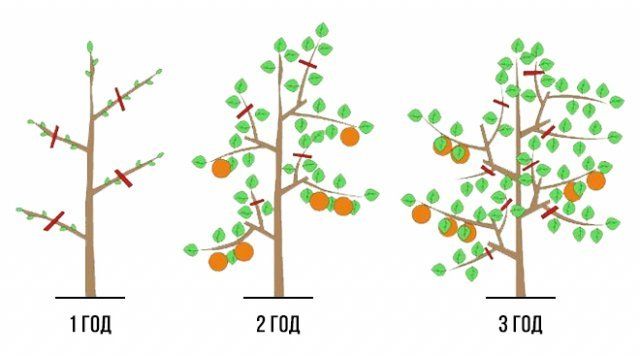 Autumn apple pruning scheme for beginners
Autumn apple pruning scheme for beginners